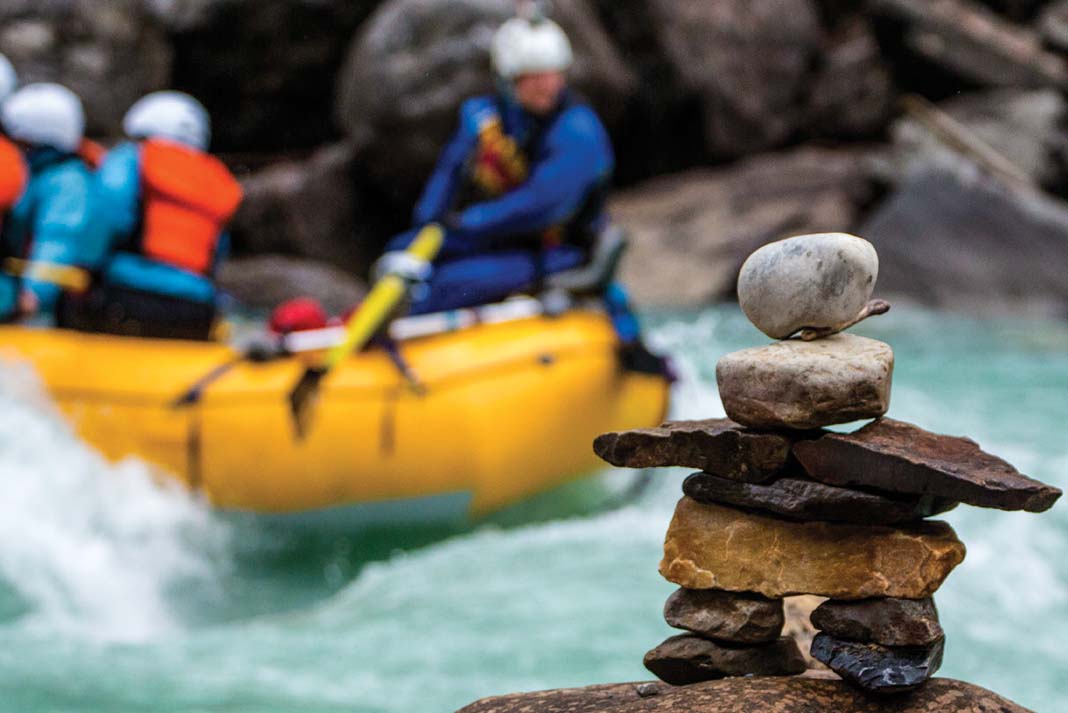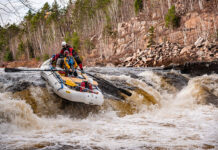August 16, 1899, is the date most historians point to as the start of North America’s adventure tourism industry. It was the day that Christian Hasler and Eduard Feus stepped off Cana- da’s newly completed coast-to-coast Canadian Pacific railway; seasoned Swiss mountain guides imported to lead vacationing gentleman into the unexplored Canadian Rockies.
Archived images of the two dressed in woollen blazers and hobnailed boots make it an appealing and enduring creation myth. But it’s all wrong.
Guiding dates to the earliest days of European settlement on this continent including First Nations guides, French voyageurs, America’s overland wagon train guides, and the celebrated timber raftsmen. Our geographic and industrial history is forged by the anonymous guide. However this history is about exploration and commerce, not recreation or tourism. Hence the myth of the Swiss guide. While their role in establishing mountain culture is undeniable, a substantial body of river guides were working eastern rivers a generation before Hasler and Feus stepped off the train.
At the end of the eighteenth century, the only people with time and money for recreation were gentleman industrialists and professionals. This privileged class brought with them their English sensibilities and ideals of sportsmanship. They enjoyed horse- back riding, trekking in the moun- tains and hunting for fox. These were noble pursuits, character building and rejuvenating.
As sportsmen explored outwards from the eastern seaboard’s growing cities in the 1830s, they knocked on fur trading post doors to request lodging and guiding down the rivers to the best hunting and fishing. Homesteaders saw this opportunity and turned from subsistence farming to outfitting, creating the backcountry lodge as we know it today.
With this movement toward outfitting came more and more guides. Local woodsmen and trappers found they could supplement their income by bringing sportsmen along.
They shared their previously unappreciated river running skills, such as poling up rivers and running rapids. Unlike their industrial guiding cousins employed in the fur trade, these early sports guides showed little fear of whitewater and enjoyed running rapids in an era long before life jackets.

Outdoor tourism remained more or less unchanged for nearly a century—affluent outdoorsmen hiring local experts to safely guide them to the best places. Guiding required real competency and intimate local knowledge. All of this was flipped on its head in the 1960s. Automobiles, highway systems and a burgeoning middle class saw the rise of the vacation.
Combined with an emerging environmental awareness, total novices were now heading for the wilderness for adventure. Outfitting became mobile, and traveling with it a new breed of guide anchored not to a place but to a particular set of skills. Guides became technical experts and activity supervisors, escorting tourists to places where they themselves where only visitors.
This paradigm is still prominent today. First hand local knowledge and our value of “place” has been shuffled aside and replaced by customer service standards and the importance of “experience.” Connection to place adds richness to experience. Guides as tourists just commodifies the wilderness, rather than making it the whole point of the adventure.
Of course this intimate knowledge of place—what makes guided wilderness trips so valuable—can be learned.
To do so, guides need to become students of the places in which they travel, rather than just showing up and imposing our skills upon them. River guiding has a long and honorable tradition, to which we can pay homage simply by immersing ourselves in the places in which we paddle. By striving to become the most recent iteration of intimate local knowledge, we create real value in the trips we run by attaching what our clients experience to a living, breathing river.
Jeff Jackson is a professor with Algonquin College’s Outdoor Adventure guide training diploma and the co-author of Managing Risk: Systems Planning for Outdoor Adventure Programs.

Subscribe to Paddling Magazine and get 25 years of digital magazine archives including our legacy titles: Rapid, Adventure Kayak and Canoeroots.








